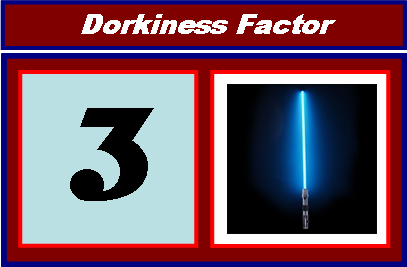The Most Awesomely Named Things Ever
The Most Awesomely-Named Things Ever (Aside From Timeblimp.com)
Let’s say you’ve created or discovered something. Something amazing. It’s going to revolutionize sorting algorithms, or maybe rids the world of dishwasher soap scum, or provides a breathtakingly original yet heart-rending perspective on the Ottoman Empire. Do us all a favor — COME UP WITH A COMPELLING NAME FOR IT! You ain’t doing yourself any favors by naming your new algorithm “partial gradient perturbative optimization”. And please don’t name your sci-fi epic novel the “Something Something Chronicles”. We don’t need more chronicles. Think about the term “Black Hole” — the physicist John Wheeler popularized this catchy term, which in my opinion helped this particular astronomical concept become a household name. Have you ever heard of a “gamma ray burst”? No? They’re arguably as cool as black holes, but have a generic-sounding name and so are an also-ran in the race for astronomical fame.
In a sea of boring, overly-technical, unimaginative names for concepts, there are a few gems that stand out for their sheer awesomeness. In this article, we collect the most awesome names found across science, history, culture, wherever — these are names for real concepts, names that appear in the academic journals, names that are spoken without a giggle by people with PhDs. Enjoy! And if you have any to add to the list, we welcome any and all nominations to the list. Give us your best nomenclature by email or by twitter!
The Hairy Ball Theorem —  Imagine a hairy ball. For about half of you, simply look down. Now imagine that your job is to comb all the hair flat on this ball — break out your hairbrush and get to work, because I don’t want to see a single cowlick on this ball. (Don’t ask me *how* you got this horrible job, just be glad I’m not having you comb something else.) Seems easy, right? Just start brushing around the ball and… hmm, now there’s a cowlick at the top. We’ll just comb that down and then… now there’s one at the bottom. Oddly enough, it turns out that it is mathematically impossible to comb down the hair on a round ball completely flat everywhere on the ball — somewhere, there’s going to be some hair sticking up that can’t be combed flat. Where the hell did this come from? It’s a theorem from the world of algebraic topology — for a ball covered with a continuous vector field (a mathematical function that points in a particular direction, at every spot on the sphere), not all of the vectors can be pointing tangent to the sphere’s surface (i.e. flat) — somebody’s got to be sticking straight out. Sounds strange, but if you physically picture combing a hairy ball (say, a coconut, or a koosh ball), you can sort-of convince yourself that this weird fact is true.
Imagine a hairy ball. For about half of you, simply look down. Now imagine that your job is to comb all the hair flat on this ball — break out your hairbrush and get to work, because I don’t want to see a single cowlick on this ball. (Don’t ask me *how* you got this horrible job, just be glad I’m not having you comb something else.) Seems easy, right? Just start brushing around the ball and… hmm, now there’s a cowlick at the top. We’ll just comb that down and then… now there’s one at the bottom. Oddly enough, it turns out that it is mathematically impossible to comb down the hair on a round ball completely flat everywhere on the ball — somewhere, there’s going to be some hair sticking up that can’t be combed flat. Where the hell did this come from? It’s a theorem from the world of algebraic topology — for a ball covered with a continuous vector field (a mathematical function that points in a particular direction, at every spot on the sphere), not all of the vectors can be pointing tangent to the sphere’s surface (i.e. flat) — somebody’s got to be sticking straight out. Sounds strange, but if you physically picture combing a hairy ball (say, a coconut, or a koosh ball), you can sort-of convince yourself that this weird fact is true.
Yes, but what does this have to do with tropical storms? Good question. It just so happens the Earth is a ball, and it so happens that *wind* is a vector field. Invoking the Hairy Ball Theorem, we see that if there’s any wind moving on the earth at all, there MUST be some spot somewhere on the earth where we see a “wind cowlick” — i.e. no wind at all. What must this point be? The eye of a cyclone storm! That perfectly-still spot of air inside the center of a hurricane is topologically equivalent to that little swirling of hair at the top of your head surrounding your cowlick. (I’m looking at the top of your head right now. Now I’m about to stick my finger in your ear.) So logically, as long as there’s some moving wind on the surface of the earth somewhere, there *must* be at least one storm someplace. Furthermore, if you discover a new planet with wind but with no cyclone-style storms, the planet must not be ball-shaped — you’ve likely landed on a doughnut-shaped planet, for the Hairy Ball theorem no longer applies if the shape has a hole.
Incidentally, this spot in the Most Awesomely Named Things Ever list used to be occupied by the The No-Hair Theorem, coined by John Wheeler about black holes. (Why do black holes get all the cool names in physics?) I had thought this was an awesome name, until Ross Churchley (@rchurchley) and Cheng Lee (@chenghlee) both pointed out to me how much The Hairy Ball theorem totally kicks the No-Hair Theorem’s ass. Thank you to Cheng and Ross, for introducing me to Hairy Balls. Wait, I didn’t word that quite right…
When it comes to badass names for legendary historical figures, nobody beats the Celtics. Well, maybe the Lakers beat the Celtics, but that’s it. Finn McCool is not a made-up name. This the *real name* of a *real* mythological being from ancient Irish mythology. While the name “McCool” wouldn’t be that impressive if you made it up yourself (and in fact would get you thrown out of a sitcom writer’s room for hackiness), the fact that this is the REAL NAME of someone, that his Gaelic name (Fionn mac Cumhaill) translated to “McCool” in English, is what makes this perhaps the Best Named Person From History Ever.
And what makes it even better? McCool was a cross between Paul Bunyan, Chuck Norris, and the Sean-Connery Highlander of ancient Ireland. As a child, he somehow managed to catch the Salmon of Wisdom (I know, right? I’ve been trying to catch that thing for years!), which imparts infinite knowledge to whomever eats it. As he was cooking it, he burnt his thumb, which he then stuck in his mouth to soothe. Which (of course) rendered his thumb magically endowed with the Salmony wisdom. From that point on, he could call upon an infnite storehouse of knowledge simply by SUCKING HIS THUMB!!! By adulthood he was a giant, a hero of ancient Ireland, and the origin of many Bunyanesque origin stories for many Irish natural wonders, such as the Giant’s Causeway. He was also the leader of a band of badass knights called the Fianna, and was badass enough to saddle the rest of them with the name “Fianna” while he got “McCool”. And demanded they all take the first name “Sue”.

“Hapax Legomenon, ASSEMBLE!!! Now — APPEAR ONLY ONCE IN A NOVEL BY CHAUCER!!!!”
Students, consider the following ratio: (coolness of concept’s name) / (coolness of the concept itself). Some concepts have extremely low ratios — stupid boring name but fascinating topic. The “Standard Model” for instance, has a name completely unworthy of how amazing the topic itself is. Other ideas have a name far more grandiose than the concept deserves. The Hapax Legomenon has hit the name lottery — it has the largest ratio of coolness-of-name to coolness-of-concept that I can think of.So what is it? A giant robot, sworn to defend the universe, who forms from five smaller robots? Nope — it’s simply the name we give to a word that only appears once in a particular work of literature. For example, “Honorificabilitudinitatibus” appears once in Shakespeare’s works. So it’s a hapax legomenon. And that’s it. Kind of a letdown, eh?
The Zanclean Flood — I think we can all agree that the Hapax Legomenon doesn’t deserve its grandiose name. Well, meet a concept that deserves its awesome name, and then some. The “Zanclean Flood” is so cool, he just stole your girlfriend. Wait, it’s also known as the “Zanclean Deluge”? *faints* I first stumbled across the Zanclean Deluge researching one of my favorite ancient myths of all time. The myth is that humanity’s many legends that refer to great floods (such as Noah’s Ark) are dim echoes of memories of a real event, of the catastrophic flooding of a fertile homeland that we’ve long forgotten about. And this ancestral land was located where you might not expect: the floor of the Mediterranean Sea. The hypothesis is that in the ancient past, the Mediterranean sea was dry, an enormous valley protected from the Atlantic Ocean by a land connection between Africa and Spain at Gibraltar. This natural dam abruptly failed at some point, unleashing the full force of the ocean to pour into the (unfortunately inhabited) Mediterranean basin. Cool, eh? What’s even cooler is that THIS ACTUALLY HAPPENED — we can tell from geological and archaeological evidence that the Mediterannean sea floor used to be a dry below-sea-level sitting duck that was rapidly inundated by the Atlantic once the land bridge at Gibraltar failed. What’s slightly less cool is that this flooding event couldn’t be the underlying event we dimly recall in our flood myths, as it happened over 5 million years ago. But we have the good fortune that this event was given the spectacular name of “The Zanclean Flood”. Nice save, geological historians!
I think we can all agree that the Hapax Legomenon doesn’t deserve its grandiose name. Well, meet a concept that deserves its awesome name, and then some. The “Zanclean Flood” is so cool, he just stole your girlfriend. Wait, it’s also known as the “Zanclean Deluge”? *faints* I first stumbled across the Zanclean Deluge researching one of my favorite ancient myths of all time. The myth is that humanity’s many legends that refer to great floods (such as Noah’s Ark) are dim echoes of memories of a real event, of the catastrophic flooding of a fertile homeland that we’ve long forgotten about. And this ancestral land was located where you might not expect: the floor of the Mediterranean Sea. The hypothesis is that in the ancient past, the Mediterranean sea was dry, an enormous valley protected from the Atlantic Ocean by a land connection between Africa and Spain at Gibraltar. This natural dam abruptly failed at some point, unleashing the full force of the ocean to pour into the (unfortunately inhabited) Mediterranean basin. Cool, eh? What’s even cooler is that THIS ACTUALLY HAPPENED — we can tell from geological and archaeological evidence that the Mediterannean sea floor used to be a dry below-sea-level sitting duck that was rapidly inundated by the Atlantic once the land bridge at Gibraltar failed. What’s slightly less cool is that this flooding event couldn’t be the underlying event we dimly recall in our flood myths, as it happened over 5 million years ago. But we have the good fortune that this event was given the spectacular name of “The Zanclean Flood”. Nice save, geological historians!
Sonic Hedgehog — You’ve heard of him, right? Pretty awesome name for a video game, I gotta say. And what’s more, it’s an astoundingly awesome name for a gene. There are several genes in the “hedgehog” family, so-named because the first to be discovered has the unfortunate side-effect of inducing spiky growths on flies, if mutated, rendering the poor little flies hedgehog-like. Later on they found a couple more hedgehog genes, including “Desert hedgehog” and “Indian hedgehog” (named after species of hedgehog), and then came “Sonic Hedgehog”, named for (of course) the popular video game. Pretty silly, eh? Later researchers have continued the fun by naming an inhibitor of the Sonic Hedgehog protein after the bad guy from the video game, Dr. Robotnik. Somewhere in your body, you’ll find a few drops of the nefarious protein robotnikinin, out to hunt down and catch Sonic Hedgehog proteins.
Glossolalia — This name makes the list in part because of how fun the word is to say. Try it. Say “Glossolalia”, and really let your tongue flop around at the end. Now try saying it with a mouth full of jello. Fun, eh? Glossolalia is the technical term for “speaking in tongues”, as you hear about in various churches around the world. Some believe those that speak in tongues are actually speaking in the language of the angels, while others think it’s a mass delusion or learned behavior. I personally think the term for it is just the bees’ knees. Almost as goodly-named is “xenoglossy”, the speaking of a real language that you (up to this point) didn’t know how to speak. Usually these are cases where someone wakes up from a coma with the unexplained ability to speak Norwegian or somesuch.
Imagine in your mind’s eye what the hell a “Gag Knuckle Zinc Finger” might be. What sort of object could that name describe? What surreal abomination has a knuckle, zinc, and gagging capability? Some sort of ungodly biomechanical hybrid with prongs, pistons, maybe some hair, and like an elbow sticking out? And what must it be capable of? Surely, if you come across this thing in a dark alley at night, you are going to get the gagging of your life. So what is this horrid contraption that haunts our dreams? Oh, just a little protein, that’s all.
Most biochemical nomenclature is uber dry, but every once in a while you stumble on a pocket of WTF-ingly named molecules. A “zinc finger” is a particular shape taken on by certain proteins. They apparently can look like little fingers, and sometimes contain a zinc atom. There are several kinds of zinc fingers, but my favorite is the bowel-shakingly-awesome name of “Gag Knuckle Zinc Finger”. These guys get their name from 1) looking like a little knuckle, and 2) having something to do with group-specific antigens (abbreviated “Gag”). Aside from the Gag Knuckle, you also find the charmingly-named “Treble Clef Zinc Finger”.
Bet you didn’t know the divide symbol ÷ , the little line with the dot above and below, had a name! Yep, it’s properly called an ‘obelus’. And while we’re at it, a forward slash is a ‘solidus‘, the backwards-P paragraph typesetting symbol ¶ is a ‘pilcrow‘, and the infinity symbol is a “lemniscate“. Man, punctuation has some weird names. Come to think of it, who the hell decided ‘ampersand’ was a good name for a symbol? Did a six year old who got into mommy’s caffeinated soda stash come up with these names? If so, then his 3-year old brother came up with the interrobang.
Hold the phone — I’ve been guilty of punctuational overgeneralizationness. The solidus, which looks like a forward slash, is actually different than the forward slash. Apparently, the solidus is at a slightly steeper angle. And then there’s the virgule, which is yet another species of right-leaning lines that is apparently reserved only for fractions. I haven’t yet found it, but I’m certain that there’s an ANSII standard for what angle each of these should lean at.
Ecophagy — If you know your greek roots, you know that “phage” is related to eating. You got yer “necrophagy”, eating dead stuff, yer “coprophagy”, eating shit, and “foliphagy”, eating leaves. Guess what “ecophagy” is? EATING AN ENTIRE ECOSYSTEM. Specifically, this refers to the “Whoopsie-daisy!” moment where a swarm of self-replicating nanobots gets out of control and starts uncontrollably devouring its surroundings. Commonly referred to as “gray goo“, its a hypothetical worst-case scenario that could arise out of nanotechnology if someone is able to create a tiny device that can make copies of itself using raw material scraped from the environment. If you forget to put in some sort of safeguard, then your little device can rapidly become *many* devices, who rapidly procreate their way through your basement lab, devour your house, then your neighborhood, then your city, and eventually the entire earth in rampant exponential growth. Cool huh?
Pangaea Ultima — A while ago, I wondered if there were other super-continents other than the famous one we all hear about, Pangaea. Everyone learns about that period of prehistoric earth when the continents all huddled together into one giant super-continent called Pangaea. But then the class moves on to the next topic, implying that Pangaea was the very beginning of continental history. But were there other super-continents earlier than Pangaea? And will there be more in the future? Turns out, awesomely, YES! And they all have awesome names. Here’s what they didn’t teach you in 3rd grade Earth Science class: the process of continental drift is responsible for something called the Supercontinent Cycle, whereby the various continents periodically bunch up together into mega landmasses, then disperse again, over vast epochs of time. In one theory, there have been several supercontinents before Pangaea, including Pannotia, Rodinia, Kenorland, and (my favorite) Ur. Strike that — while Ur is my favorite supercontinent from the past, my all-time favorite supercontinent is (or rather will be) Pangaea Ultima, one of several hypothesized future supercontinents that we might see in the next several million years.
The Wiener Measure — Get your mind out of the gutter! No wait, you might as well stay in the gutter, because the topic area this refers to is dry as a mistakenly-eaten dessicant packet. My friend @chenghlee reminded me of a name that causes all immature math students to have to stifle snickers or get kicked out of class. A Wiener process is a mathematical idea related to random walks, and a Wiener measure is somehow related to probability estimates on Wiener processes. Suffice it to say these concepts relate to a mathematical model of randomness — like the apparent randomness of stock market prices, electrical signal noise, and other random processes.You know what, I’m not going to be able to explain a Wiener process — take a look at this one instead:
Hypnotizing, eh? This comes from wikipedia, and is attempting to show us that zooming in on a Wiener process gives us more Wiener process. And we could all use a little more Wiener.
This measure (and lots of other concepts in math and engineering) is named for Norbert Wiener, a famous american mathematician from the first half of the 20th century. Laughing at his name, are you? Well, I certainly am — I first heard his name referring to Wiener filters, which sounds pretty painful. Well get this — little Norbert graduated from high school at 11, coolege at 14, and got his freaking PhD in math at 17 years old. What were you doing at 17 years old? Probably studying your Wiener processes, if you get my drift…

Adriaan Fokker is so sick of your “Fokker” puns. Come back when you can stop laughing, wise guy, and he’ll let you play his organ. Dammit, stop laughing!
The Fokker Organ — When @chenghlee reminded me of all the “Wiener” terminology in math, I remembered another name that nearly caused me to be expelled from college. “Wiener” got you snickering, but when you read about the “Fokker-Planck” equation? Hoo boy, keep it together… don’t commit a snicker-fart in your quantum lecture… Adriaan Fokker was a famous physicist who studied with Einstein, and whose name should be familiar to physicists and engineers from his various contributions in several areas. What I didn’t know was that he was also an accomplished musical theorist, and designed and built a musical instrument called the “Fokker Organ”. Oh yes, the Fokker Organ. Think you can play a Fokker Organ? I know you want to play the Fokker Organ (everyone wants to play the Fokker Organ), but lemmie tell you buddy — the Fokker Organ is harder than it looks.
They don’t tell you in physics class that Fokker was just as good at music theory as physics, to the point of designing and constructing a keyboard capable of more than just the typical 12-note-to-the-octave tuning we’re used to in western music. Specifically, he built an organ designed to handle the “31 equal temperament” tuning, in which the octave is divided into 31 notes. Man, I thought physics articles were hard to understand until I read the wikipedia page on 31 equal temperament. Though I haven’t learned from wikipedia why 31 notes per octave are so cool, I can see that the typical piano key layout (black and white keys, all in a row) isn’t going to cut it. No, Fokker had to to delve into the world of “Generalized Keyboards“, keyboard layouts that resort to using 2 dimensional arrays of keys to encompass all the strange new notes that appear in these finer-grained tunings. These things are majestic — a google image search on generalized keyboards will bring up examples that look like someone playing an Othello board. I bet playing Fokker’s Organ for a while is really hard on the fingers… (nyuk nyuk)
This might be one of those cases where, against all odds, the topic itself is even cooler than the awesome name. Somebody remind me to come back to this rabbit hole some day for another article. In the meantime, want to play Fokker’s Organ for yourself?
Ooo, is that hangnail bothering you? Poor baby — console yourself that you don’t also suffer from EXPLODING HEAD SYNDROME, the most awesomely-named medical condition in existence. This condition (brought to my attention by @badphysics on twitter) is apparently a type of hallucination you can get while falling asleep. Without warning, every once in a while you hear a horrendously loud noise as you drift off to sleep — it’s not a real noise (nobody else hears it), doesn’t leave you with any lasting damage (no bleeding, nothing snapped), but it sure sounds to the sufferers like an explosion coming from inside their own heads. It seems to be harmless, but it surely must be a pants-enshittening moment for those who suffer from it. Nobody knows what causes it — we’re not even sure if it comes from some sort of inner-ear hiccup or if it’s entirely in the brain. Like all of these topics, part of my joy in the weird name is the thought that somewhere a doctor is soberly discussing “Exploding Head Syndrome”. Perhaps standing in a lecture pointing to a powerpoint with “remedies for exploding head” on it.
You’ve probably heard of “cosmic rays” — these are really high-energy crud (either subatomic particles or photons) that bombard the earth from outer space. What makes them cool (and so dangerous to astronauts) is that they’re *really* high energy — essentially nothing on Earth, in our solar system, maybe even our galaxy produces anything with this much energy. They’re essentially random death rays shot from unknown parts of deep space at unpredictable times, and have been a puzzling mystery in the astrophysics community for a while.
I exaggerate by calling them “death rays” — they’re very energetic, but they aren’t actually going to kill you. Oh, perhaps except for the ultra-high-energy cosmic rays, such as the “Oh My God” Particle. Back in 1991 researchers at the Fly’s Eye II detector in Utah detected an unbelievably high energy cosmic ray in their telescopes — while not entirely sure, scientists concluded it may have been a proton moving really fast. REALLY fast — just a smidge under the speed of light, in fact. This proton was moving so fast, that if it were lined up in a race head to head with a beam of light, after *one year* the proton would only be 50 nanometers behind in the race. This thing had *much* more energy than anything we generate in our most massive particle accelerators — millions of times more energy than any proton currently hurtling through the LHC. Hell, this little proton had as much kinetic energy as a thrown baseball, or (as put by physicist Pierre Sokolsky) “a brick falling on your toe”. For a subatomic particle! (Thanks again to @badphysics on twitter for recommending this awesome name!)
So where did it come from, and how did it get moving that fast? Nobody knows — this is an unsolved problem in astrophysics, so far. Very weird, and very awesome name. There’s also the equally charming Wow! Signal a potential signal from alien intelligence that I’ve written about elsewhere — note that the exclamation point is part of the name. If these were the names that made the cut to publication, imagine what other colorful names for discoveries got swept under the rug? The “Holy Shit! Signal”? The “Oh Yeah, A Little Lower Graph”? The “We Can’t Publish This Rubbish Dataset?” Or the one I discovered back in grad school, “Oh Damn, The Damn Recorder Wasn’t Plugged In Experiment”.
But my best guess is that an “Oh My God!” Particle is the most likely response we’ll receive from alien civilizations, when they finally get this message we sent them.
Did you know there are scientists listening to undersea microphones, hoping to pick up clues about various oceanic mysteries? And did you know that sometimes they pick up strange and unexplained sounds? Sure, most of the time all they hear is some fish burps, undersea vents, maybe a Russian sub or two. But every once in a while, scientists pick up an acoustic signal that are simply baffling. And @badphysics on twitter, who recommended an unbelievable panoply of awesomely-named things for this article, pointed all of this out to me.
The “Bloop” is a semi-famous event from back in 1997, when scientists listening in on undersea sounds picked up a strange sound — a very loud, low-frequency noise they call the “Bloop”. At the time nobody knew what could have caused it, so naturally conspiracy theorists ran wild with suppositions that it came from some heretofore unknown sea creature, mermaids, or (my favorite) Cthulhu. Later, it turned out the bloop has a perfectly normal explanation — icequake! The sound matches pretty well with later recordings from disintegrating icebergs, so scientists declared “case closed” and have moved on from the hulking ferocious beast that actually made the noise. (Kidding!)
“Bloop” was just one of many whimsical names that the NOAA scientists coined for unexplained sounds — you’ve also got “Whistle“, an unidentified sound picked up in the Pacific in ’97, “Slow Down” also from ’97 (so-named because it decreases in frequency), and “Julia” from ’99 (so-named because I don’t know why — I’m hoping the discoverer just went ahead and named it after herself).
This one’s fresh off the press! When I heard about a new astronomical object called a “blitzar”, I knew someone finally read my advice about evocative names. What possible object could evoke the otherworldly burn of a pulsar, with the relentless evil of the nazi blitzkrieg? Well, a dying pulsar, of course!
When we learn about the life cycle of stars back in kindergarten, we hear that stars that are sufficiently large will collapse on themselves and form a black hole. But what happens, exactly, during a collapse? Specifically, imagine one of them pulsars (or a rapidly-spinning neutron star) submitting their resignation from the position of “visible objects”, and disappearing from view as a black hole. These neutron stars sometimes have very strong magnetic fields, and these magnetic fields will find themselves abruptly homeless once the star collapses. Suffice it to say, a powerful magnetic field will not take kindly to being cut off from the stellar core that created it, and will unleash all kinds of hell on the neighbors as it snaps back into a more comfortable configuration. As a result, scientists hypothesize a giant spray of radio waves will result. So what do we see back on Earth? A brief instant of extremely intense radio waves from some spot in the sky that just as suddenly disappears — as if Galactus decided to crank some tunes on his phone but forgot to plug in the earbuds.
 To be honest, I really have no idea what this is. Maybe you can read this review paper and make some sense of it. It’s a mathematical concept invented by the famous mathematician John Conway, who is also the inventor of the Game of Life, which spawned the area of cellular automata, which was used as the foundation for a complete Theory of Everything by Stephen Wolfram. In other words, a guy worth paying attention to when he invents something.
To be honest, I really have no idea what this is. Maybe you can read this review paper and make some sense of it. It’s a mathematical concept invented by the famous mathematician John Conway, who is also the inventor of the Game of Life, which spawned the area of cellular automata, which was used as the foundation for a complete Theory of Everything by Stephen Wolfram. In other words, a guy worth paying attention to when he invents something.
Monstrous Moonshine is some abstract concept from the realm of mathematical physics. I think. Something called “Quantum Algebra”. I dunno… listen, it has something to do with this pink thing on the right.
You know a topic is going to be hard to get a handle on when the review paper on the topic starts like this:
Hmm, 196,884 = 196,883 + 1? I need to sit down…
This has nothing to do with WWII, nor Dubya’s heavy-handed term for enemies of the U.S., nor with anything political. The “evil” in this case is referring to the damage that a particular scientific observation will have on the prevailing theories of physics. And you can’t get more evil than that.
You’ve probably heard of the Cosmic Microwave Background, which we believe is the leftover glow of the Big Bang that emanates throughout space. Since it’s an echo of the extremely early universe, it’s the best way we have to look beyond our own little local area of the universe. So it seems a little unusual that the half that we can see from the Earth’s northern hemisphere is a little brighter than the southern hemisphere’s half — how could the Big Bang possibly have known how the Earth would be tilted, billions of years into the future? Why would the structure of the entire universe have anything to do with the Earth’s orientation? Haven’t we moved past any notion of Earth-centric design to the universe? It’s such a preposterous contrast to our current theories of the universe that it’s considered downright “evil” for our theories.
More Nominations That I Don’t Yet Have Smartass Writeups About:
- Bombogenesis — Suggested by @whitesky60 on twitter, bombogeneis is apparently “cyclogenesis taken to the extreme.” Bout time someone took cyclogenesis to the extreme…
- The Going-Down Theorem — nominated by @chenghlee on twitter. Come now, mathematical community. The Going-Down Theorem?









 Follow Timeblimp on Twitter
Follow Timeblimp on Twitter